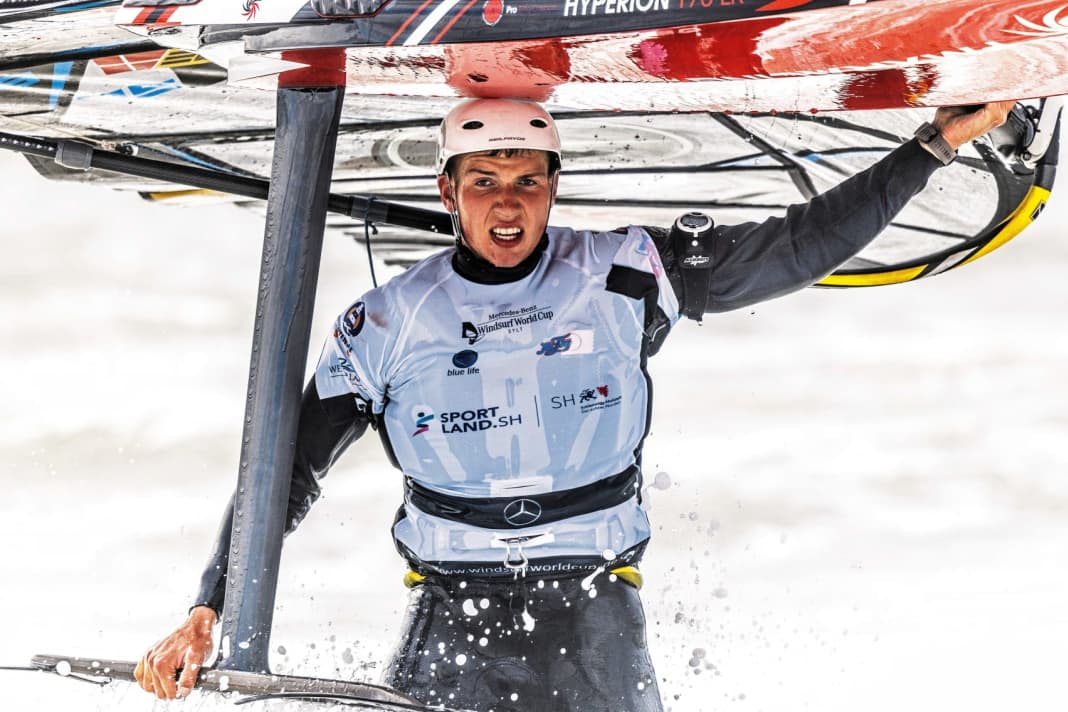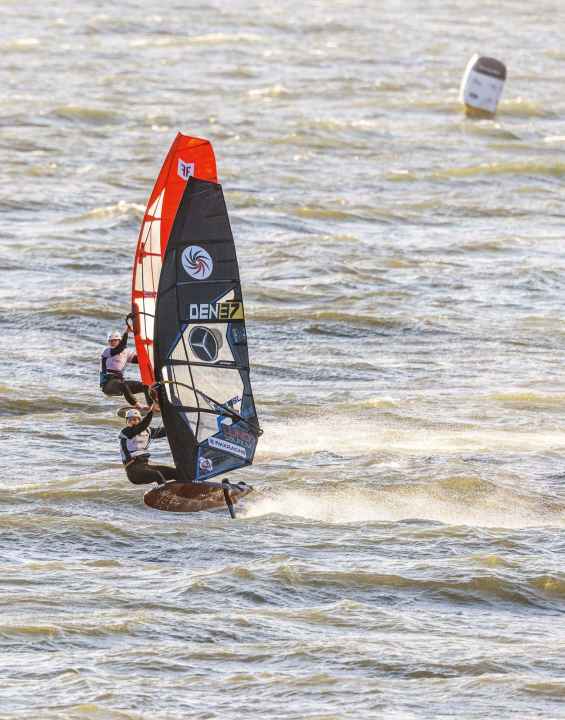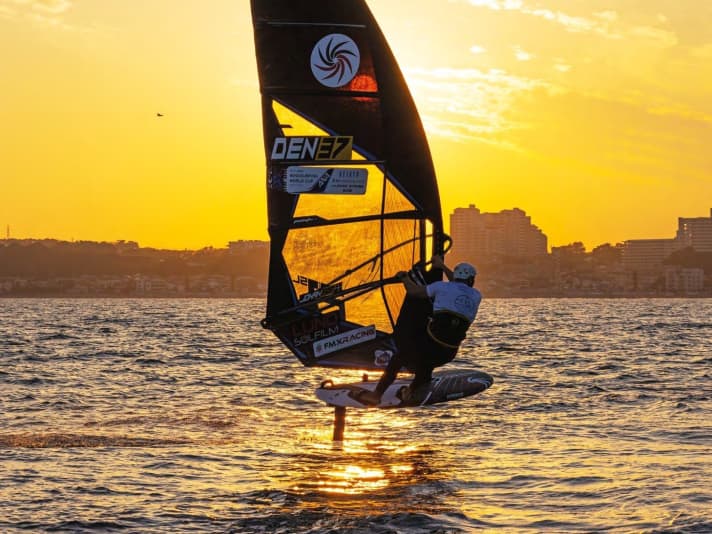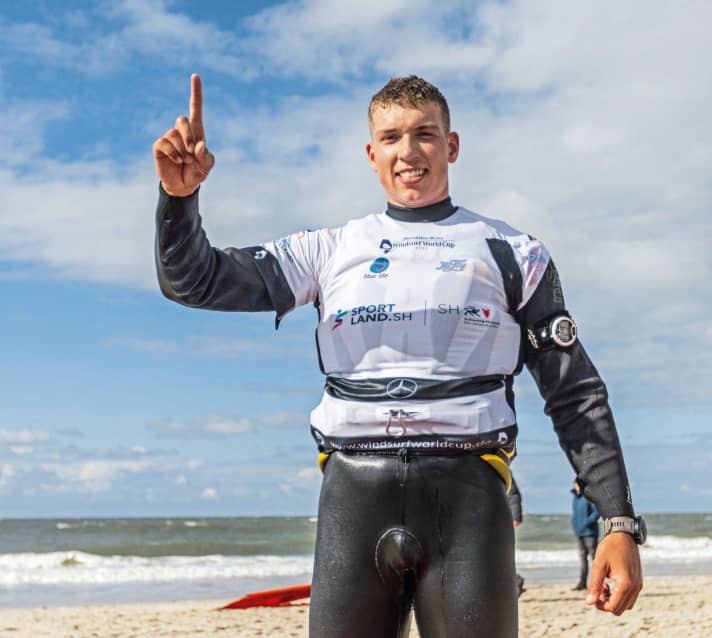Newcomer: Johan Søe - How the Dane is giving the World Cup elite a run for their money
Manuel Vogel
· 08.03.2023






There were plenty of reasons for Johan Søe to go crazy on the day of our interview. A few hours earlier, he had defied the assembled world elite at the World Cup on Sylt. He was a regular in the finals, achieved a top 5 finish four times in ten eliminations and even took his first victory in a final race. So it's time to ask "The Beast" - as he is called by his colleagues in the World Cup - for a chat.
Johan, if at the age of 19 you are reverently called "The Beast" by experienced Worldcuppers, you've done a lot right, haven't you?
Yes, maybe. It probably just shows that they recognise me - and that I've arrived.
Here on Sylt you have the won a final elimination in the World Cup for the first time . Congratulations! How much did that surprise you?
Of course, I didn't expect to win an elimination here on Sylt. But I had already taken part in the PWA World Cup in Croatia in the summer of 2022 - that was my first World Cup ever. I came very close to winning a final there twice too, but then I messed it up. In that respect, I already knew that I basically had the speed to be among the front runners. Of course, it's great that it actually worked out.

The event in Croatia was your first World Cup on the PWA Tour. You could have been the first rider to win a heat on your debut. Then came the penultimate jibe...
Yes, that was bitter. I was actually quite safely in the lead, but then I messed up a gybe without needing to and was passed to the back.
You then made up for your first victory in the final here on Sylt. Were you worried on the last beat that it might go wrong again - like it did back then in Croatia?
Of course you get antsy. When I was on the last beat, I just thought to myself: I'm not going to throw it away this time! I didn't actually know how far behind me the others were. I just had a feeling. Here on Sylt, you can't just look behind you at full speed on the foil and check the situation. I just tried to drive the thing home safely. When I managed it, it was a great moment for me.
How does it feel when you suddenly find yourself surfing against your childhood idols - and leaving them behind?
That's surreal. A year earlier, I hadn't even met people like Antoine Albeau, Mateo Iachino or Maciek Rutkowski in person. Racing with them is a dream. To be able to win against them is something I never expected.

What was it like last summer as an 18-year-old newcomer? What are the big boys like when someone like you poaches on their turf?
Most of them are really friendly and are happy when new people come in and perform well. I never had the feeling that I was met with envy or rejection here.
Let's talk about your success on Sylt. What matters most here on the North Sea?
Sylt is very special, it has a lot of current - and as soon as there is wind, there are high swells on the way. That changes a lot at the start. Normally, you have to cross the line at zero to the second at the start. Here on Sylt, that's no good if you're hanging out on the crest of a wave. It's much more important to cross the start line on the front side of a wave, a second too late if necessary. That makes the start here very difficult. I always started far downwind yesterday, which meant I had an inside position on the first gybe.
Your consistency is more impressive than your victory in Elimination Five. You have only missed the final three times in ten eliminations here - a level of consistency that even the most experienced Worldcuppers rarely achieve. Where does this determination come from?
I mostly train at home in Arhus, sometimes also on the Olympic iQFoil. I have friends and a few older racers who also have World Cup experience as training partners. Even though I'm still young, I've been to a lot of competitions, which has improved my level enormously. I soak up the experience from every competition and try to learn something from it.
In winter, many pros train in Tenerife for the next season. What's it like for you?
I'm still going to school until the summer of 2023, so I'll be training on the cold Baltic Sea again. But after that, I definitely want to become a full pro and ride the entire PWA Tour. I want to win the tour one day and become world champion. But all in all, my home is a great place to train. The region east of Arhus offers a lot of wind and great conditions. There's a big scene there - and lots of freeriders and racers on the water. We also have an iQFoil group there.

How are you currently being supported?
As a young driver, it's not so easy to get your foot in the door. But I've now found good sponsors who are helping me a lot. Andrea Cucchi(Founder of the Point-7 brand, the ed.)and Finian Maynard from FMX Boards have been supporting me for a while now - and I recently got my foils from F4 Foils. So I've got the whole package together and can fully attack. I also have a few smaller local sponsors. But a result like yesterday helps of course (laughs). Here on Sylt, we already have a decent fleet. I've registered four foil sails from 5.8 to 9.0 square metres with two large foil boards, plus two slalom sails of 6.2 and 7.1 square metres and two boards for fin races in very strong winds. This would not be possible without sponsors.
You mentioned the Olympic iQFoil discipline. Is that something you also put time and energy into?
The problem with the Olympic iQFoil is that you have to do it all or not at all. You can't do it on the side, the level is too high in international comparison. I was at the European Championships in the summer of 2022 and became European champion in the under-21 class. Also a Gold Fleet Race(without age restriction, the ed.)I have won. I'm currently still doing iQFoil and the PWA World Cup at the same time. But I have to admit that my heart is currently beating a little stronger for the World Cup. On the other hand, the Olympic Games would of course be something unique. We'll see where the journey takes us. Another goal of mine is to become part of the development team at my sponsors. I not only want to understand the material better, but also give my input to improve it. I've already been able to get a taste of Andrea Cucchi's work.

How did you get into windsurfing in the first place? Do you come from a typical surfing family?
No, not at all. I just saw windsurfers on the beach in Sardinia at some point and then I wanted to do it too. When I was twelve, I took a course at a club here in Denmark and my dad was there too. A short time later, we bought our first piece of equipment. We had finally found something we could put all our money into (laughs).
Do you also do other disciplines? Freestyle, for example, to get your mind off things?
Like every teenager, I used to do a bit of freestyling. But the more professionally I practise the slalom discipline, the less time I have for it. Because slalom can take place in virtually any wind, you have to invest a lot of time in getting the equipment perfectly set up in all wind conditions. Of course, that's a shame sometimes, but I also really enjoy slalom.
Would you say that the foil discipline is the most complex of all?
Absolutely! Take a look at iQFoil. We're talking about a standardised class here, everyone uses the same material. Despite this, you have an almost infinite number of levers with which you can optimise your equipment. In the Slalom World Cup, with all the equipment on the market, there are almost no limits to the adjustments you can make. It's not about such trivial things as the trim or the board size. At some point you have to think about the angle at which you set your foil wings in different conditions, how hard the battens should be in different areas of the sail and so on. On the other hand, of course, you have to be careful not to get completely bogged down and lose yourself in the details. This is often a difficult balancing act.
What adjustments can you make immediately before a race to be faster?
Yesterday, for example, I went out with my best trim, which I usually use. After the first run, I went ashore and turned the tail wing of the foil up a bit more so that it had more lift - and I didn't get caught with the nose or the windward edge in the high waves when I overtook them from behind.
At the moment, almost everyone in the World Cup is sailing on foils, even in 20 knots of wind and 1.5 metres of swell. Is the Finn finally dying out in the World Cup?
The situation in the World Cup is such that the fin is inferior in almost all wind ranges. The top speed on the straights is similar, but in the gybes you simply go just as fast on the foil and the fin falls behind. But I really hope that the fin doesn't die out in the World Cup either, because that wouldn't reflect the market at all. Many hobby surfers are better off with a fin on most days. As soon as it gets rough or wavy, people like my dad don't want to relearn everything and massacre themselves with a foil. The fin will always have an advantage in such conditions. Look at races like the Defi Wind or the One Hour on Lake Garda. The fin fields are much bigger. It would be a big mistake to eliminate the Finn in the World Cup. But that's exactly what will happen if there are no changes to the regulations. These are actually two disciplines that can't be lumped together.
Thanks for the interview, Johan!


